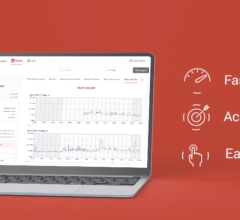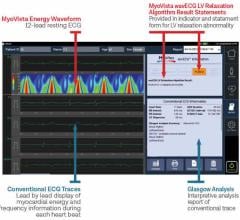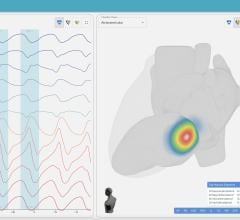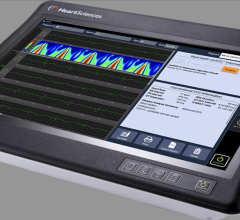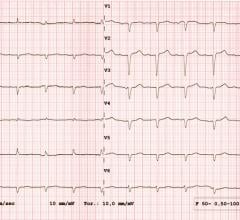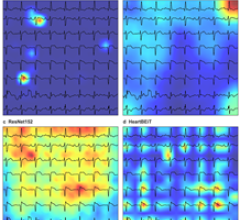
ScImage's PICOM ECG management system.
As electronic medical records become more sophisticated and healthcare moves to an increasingly paperless system, electrocardiogram (ECG) integration has become a priority for many hospitals. For hospitals that have been using ECG management systems, many are upgrading to newer systems that offer better integration with their ECG systems, interoperability with other software systems, or offer Web-access and smart phone access.
Stage 2 Meaningful Use
There are a few recently released Stage 2 meaningful use requirements that may be applied to ECG management systems. If not required now, they might be in Stage 3, so they should be considered for planning purposes. Requirements that you should consider include:
• Use of computerized provider order entry (CPOE) when ordering tests.
• Imaging and other test results need to be accessible through a certified electronic health record.
• Use of clinical decision support (CDS) to improve performance on high-priority health conditions.
• The ability for patients to view online, download and transmit their health information.
• Clinical summaries must be provided to patients within one business day for more than 50 percent of office visits.
• Providers should be able to generate lists of patients by specific conditions to use for quality improvement, reduction of disparities, research or outreach.
Clinical decision support software is offered on some ECG management systems. It serves as a computer-aided detection tool to help identify specific types of arrhythmias, ST-elevated myocardial infarction (STEMI) and other conditions.
Cloud-Based Systems
ECG management is commonly deployed as an independent application in a client/server environment or in a self-contained Web server. For many facilities and private practices, the cost of implementing an ECG management system is difficult to justify based on modest reimbursement levels. However, Web-based software systems are now available that charge a fee per ECG. The advantages of cloud-computing based systems are the ability to access the software from any Web-enabled computer, there are no servers taking up room or that need to be maintained, and the information can usually be made accessible to referring physicians.
An example of Web-based systems is the 2012 release of ScImage cloud ECG management service as an extension of its PicomCloud cloud picture archiving and communications system (PACS). It allows users access to a full-featured ECG management system, including seven years of replicated storage, professional ECG editing tools and Web access for subsequent review for primary care providers, using a low-cost fee. Rather than using typical PDF documents for Web distribution, ScImage has developed a platform independent foundation that renders ECG waveforms on the fly. This technology provides interactive investigation of rhythm and morphology with gain, speed, pan and caliper controls.
Web-based systems may help overcome some interoperability issues and allow much easier access from remote locations, such as clinics, referring physicians and cardiologists working on cases after hours at home.
Smart Phone Integration
Many vendors are adding smart phone interoperability to their systems so ECG waveforms are immediately available to physicians anywhere. This has had a particular impact on emergency patient evaluations, such as those presenting to the emergency department with chest pain or suspected ST-elevated myocardial infarction (STEMI). The rapid diagnosis on smart phones enables earlier activation in the catheterization lab, leading to better patient outcomes in STEMI cases. The technology is especially helpful to connect with cardiologists who are not near an ECG system workstation, or at home in off-hours.
ScImage bolstered its browser-based ECG delivery utility in its PicomWeb system to offer immediate access to raw ECG waveforms. This new ECG platform presents especially well in Web tablets and smart phones.
Five Methodist Healthcare facilities in San Antonio, Texas, are now using a chest pain management solution to make pre-hospital and emergent electrocardiographs (ECGs) immediately available to cardiologists.
The Lumedx HealthView Chest Pain Management system makes ECGs immediately available to cardiologists and allows them to compare them with previous ECGs. It integrates current and historical clinical information from disparate systems into a single dashboard view available anywhere with an Internet connection.
Philips Healthcare recently added mVisum Inc.’s STEMI Alert smart phone app to work in conjunction with Philips TraceMasterVue and IntelliSpace electrocardiogram (ECG) management systems. mVisum’s STEMI Alert is a comprehensive tool designed to gather patient data surrounding an acute cardiac event and securely push it to physicians’ smart phones where is can be quickly viewed, assessed and responded to.
Need to Standardize ECG Formats
Unlike medical imaging and data that has standardized on DICOM and HL7 formats, there is no standard format for ECG waveforms. The result is an array of file formats for ECGs, including DICOM, XML, TIFF, JPEG, GDT, PDF, ZIP, DVD and others. The variety of formats may cause interoperability issues when attempting to save ECGs to a picture archiving and communication system (PACS), or if attempting to data-mine patient information for ECG reports saved as JPEGs. You will want to address these format issues with the vendor ahead of installation to ensure the waveforms generated by the ECG systems at the facility can be transferred into the system. Second, the data stored in the ECG management system needs to be retrievable by the other information systems you plan to integrate it with. As hospitals continue to integrate their systems and patient data for easier access, the ECG management system will likely need connectivity to the PACS or cardiovascular information system (CVIS), hospital information system (HIS), billing and electronic health record (EHR) systems.
Some hospitals have opted to simplify their ECG management by using ECG machines and an ECG management system from a single vendor to ensure interoperability and reduce interoperability headaches.
Training Time Indicated Complexity of Systems
Examine the amount of time typically required for training on a new system. It if requires a week of training, there is a good possibility the software is not intuitive or easy to use. If training time is minimal, it is likely the transition to the new system will be much easier. Remember the “keep it simple” principle, if something is difficult to use, people will find work-arounds to avoid using it. Complexity also increases the possibility of mistakes.
Read the 2016 updates article “Advances in ECG Management Systems.”
Comparison Chart of ECG Management Systems
This story served as an introduction to a comparison chart of ECG management systems. The chart is available at www.dicardiology.com/content/ecg-management-systems. Access to the chart requires a login, but it is free and only takes a minute to complete registration. Participants included:
Cardiac Science, www.cardiacscience.com
Epiphany, www.Epiphanycardio.com
GE Healthcare, www.gehealthcare.com
McKesson, www.mckesson.com
Norav Medical, www.norav.com
Philips Healthcare, www.philips.com
ScImage, www.scimage.com

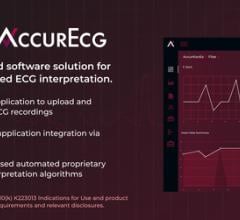
 November 21, 2023
November 21, 2023 

